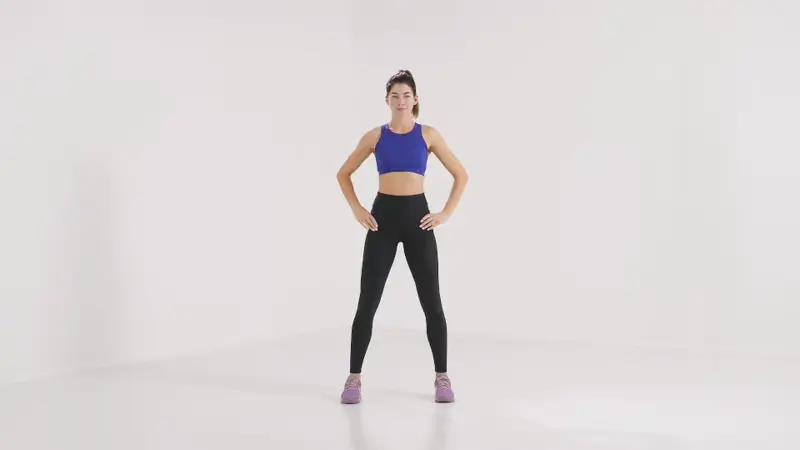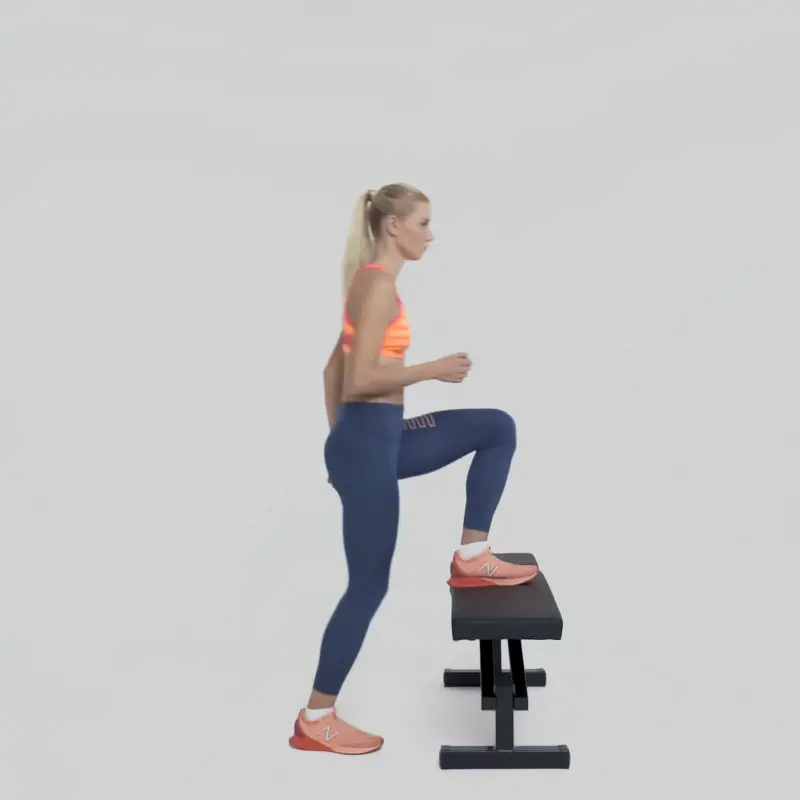Both resistance training and lower-body cardio exercises, like running, biking, or using the elliptical, are great for targeting fat around the knees. However, some exercises are more effective than others.
Here are some of the most effective exercises and their variations for reducing knee fat. Be sure to warm up your legs before starting your workout to prepare your muscles and joints. Adding a few ankle stretches and moves will also help protect your ankles during the routine.
Lunges
Lunges and their various variations are excellent for targeting knee fat and toning the inner thighs. If you’re a beginner, start with bodyweight lunges and gradually add weights as your strength and balance improve.
FORWARD LUNGE
Forward lunges require balance and core strength. To improve stability, step forward in line with your leg’s natural alignment, rather than bringing it closer to your midline. This helps maintain better control and reduces the risk of injury.

LUNGE JUMP
Lunge jumps are a dynamic variation that not only tones muscles but also burns extra calories, making them a great option for targeting fat around the knees. This exercise requires good coordination, so it’s best to add it to your routine once you’ve mastered the standard stationary lunge.

CURTSY LUNGE
For the curtsy lunge, step back at a 45-degree angle and lower your hips, sinking into your glutes. Make sure your hips are positioned behind you to avoid straining your knees and to maintain stability during the movement.

Squats
Squats and their variations are effective for targeting above-the-knee fat by working the quadriceps. If you’re new to training, begin with bodyweight squats and gradually add weights as you build strength.
SQUAT WITH KNEE-UP
The squat with knee-up is a great exercise that challenges your balance and stability. To perform it effectively, focus on activating your core and move slowly to maintain control while standing on one leg.

SPLIT SPUAT
Split squats demand muscle endurance and balance. To improve stability, position your forward leg in line with its natural alignment, keeping it directly in front of the hip. Ensure your feet are parallel and hip-width apart for better control and proper form.

SIDE MOVING SQUAT
The side moving squat helps improve muscular endurance by requiring you to hold a squat position while moving side to side. To increase the intensity, aim to keep your squat as low as possible throughout the movement.

SIDE JUMP TO SQUAT
The side jump to squat is a dynamic variation that requires mobility, coordination, and endurance. It’s ideal for individuals who have experience with squats and are looking to challenge themselves further with a more advanced movement.

Step-Ups
Step-ups are an excellent exercise for toning the muscles around the knees, targeting the quadriceps, calves, and hamstrings. Begin with bodyweight step-ups, and as you gain strength, gradually add weights to increase the challenge.
CLASSIC STEP UPS
When performing classic step-ups, avoid using a bench or step taller than knee height to prevent knee strain. Focus on maintaining muscle tension as you step up and down to effectively activate and strengthen your leg muscles.

STEP UP DOWN
The step-up-down variation requires good coordination and focus as you alternate legs on top of the step or bench. Begin by performing this exercise slowly to ensure proper form, and gradually increase speed as your coordination and confidence improve.

Jump Rope
Jumping rope is a high-intensity cardio exercise that helps burn fat throughout your body, including challenging areas like behind the knee. It’s an effective way to improve overall fitness while targeting fat reduction.
CLASSIC JUMP ROPE
The classic jump rope exercise requires good coordination and endurance. Start at a slow pace to focus on your form, and gradually increase your speed as your coordination improves.
JUMP ROPE ALI SHUFFLE
The jump rope Ali shuffle involves a shuffling motion, which requires higher coordination and agility compared to the classic version. This makes it an excellent progression for those looking to challenge themselves and enhance their coordination while jumping rope.

ONE LEG HOP
The one-leg hop is an advanced progression from the classic jump rope. In addition to coordination and endurance, it requires balance, calf strength, and core stability, making it a more challenging exercise that engages multiple muscle groups.

CONCLUSION
Incorporating a combination of resistance training and cardio exercises, such as lunges, squats, step-ups, and jump rope variations, is an effective approach to targeting fat around the knees and toning the legs. Starting with basic exercises and gradually progressing to more challenging variations will help build strength, coordination, and endurance. Consistency, along with proper form and gradual increases in intensity, will lead to noticeable improvements in muscle tone and fat reduction over time.







